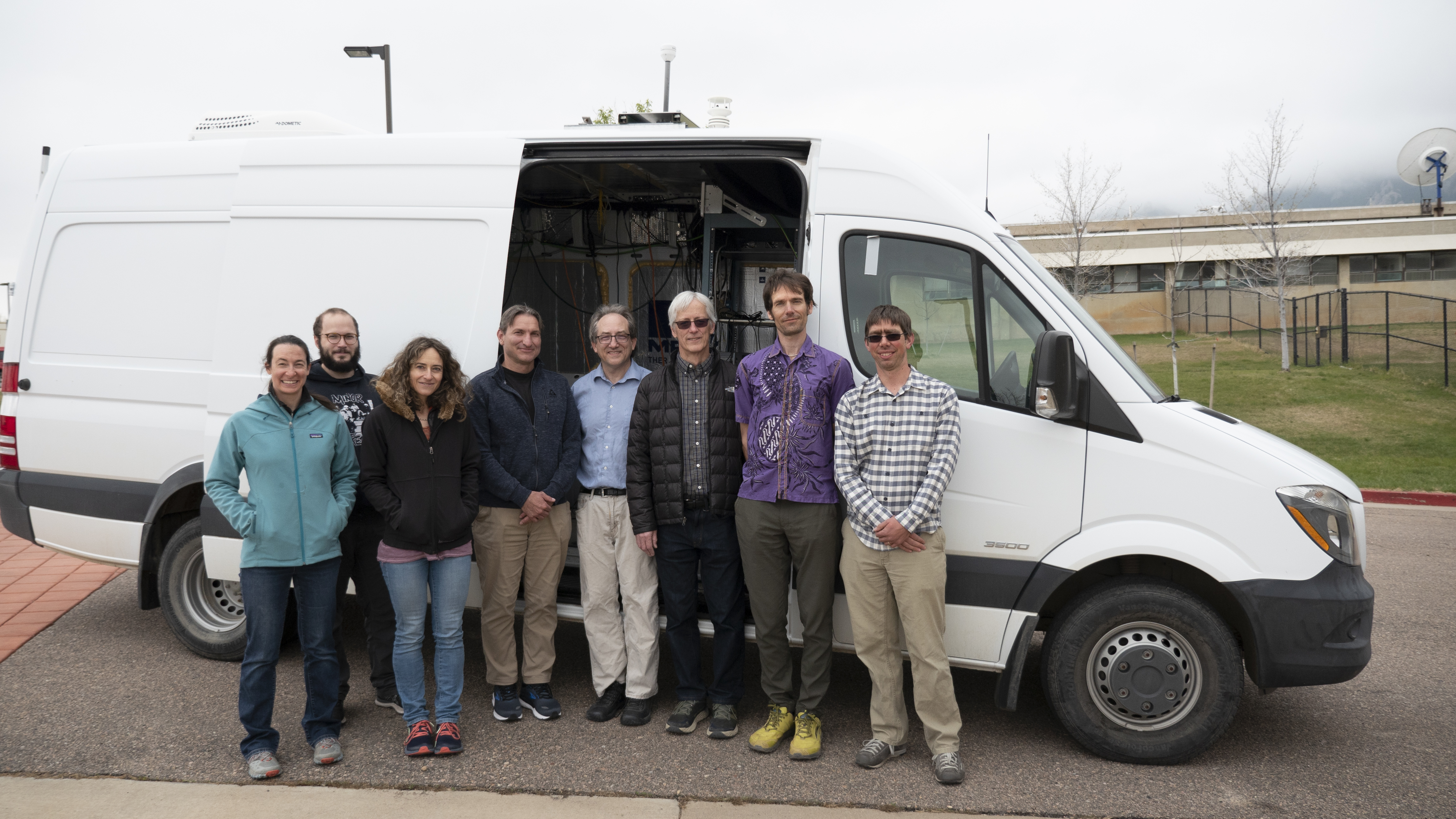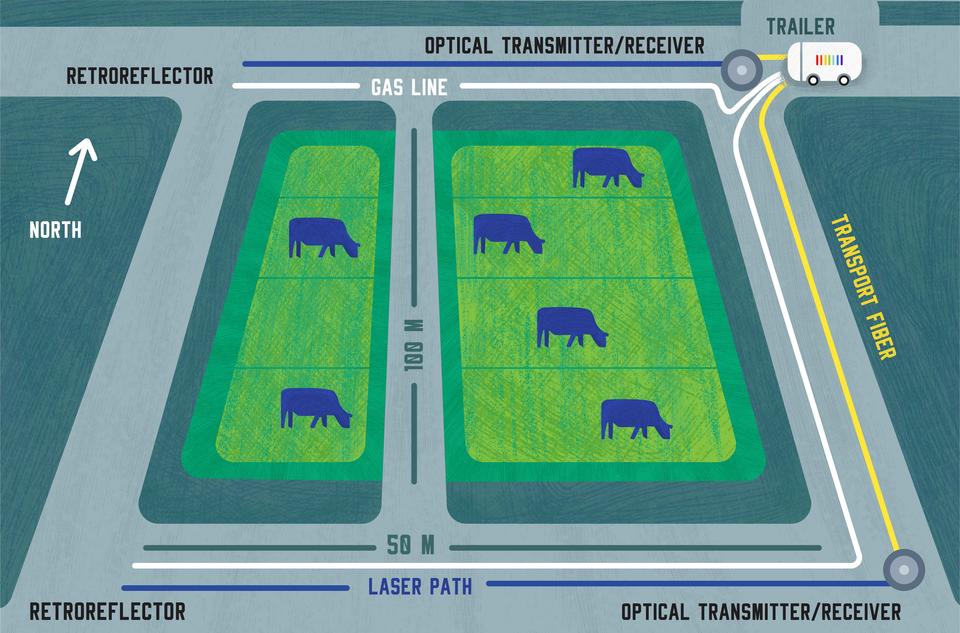Taking Measure
Just a Standard Blog
Detecting Methane Gas Leaks and Other Pollutants Using Frequency Combs: A Q&A With Sammie Finalists

Cars. Cows. Oil and natural gas leaks. The list of what is polluting our atmosphere and contributing to global warming is long and varied. And if we want to solve this problem, being able to accurately measure what’s happening is key.
NIST is contributing to this critical measurement challenge in many ways. One approach being pursued uses a Nobel Prize-winning technology called a frequency comb, which is a very precise “ruler” for measuring exact colors of light. A group of NIST scientists have been adapting the frequency comb to make these crucial measurements. In 2018, they successfully demonstrated a way to use two frequency combs to continuously and cost-effectively monitor leaks of methane (CH4) and other trace gases with extreme precision and over large areas. In 2021, those researchers upgraded the instrument so that it could simultaneously measure three airborne greenhouse gases — nitrous oxide, carbon dioxide and water vapor — plus the major air pollutants ozone and carbon monoxide. This dual-comb technology could help in understanding and monitoring emissions of the heat-trapping greenhouse gases implicated in climate change, as well as in assessing urban air quality.
Three of these scientists — NIST Fellow Nathan Newbury and scientists Ian Coddington and Kevin Cossel — are being recognized for their work. They are all finalists for a 2022 Samuel J. Heyman Service to America Medal, known as a "Sammie," in the science, technology and environment category. The citation recognizes them for developing “a revolutionary system to detect and stop methane gas leaks from oil and gas production facilities as well as identify other pollutants that are major contributors to global warming.”
Below, we talk with the finalists about their work and what’s next for the technology.
What made you think about using a frequency comb for methane gas detection? Or, in other words, what was the genesis of this work?
NATE: We were developing the basic technique of dual-comb spectroscopy and realized that it was very well suited to a precision experiment and could probably work well outside of the laboratory. It was glaringly clear even back then that climate change was upon us and that measuring methane and other greenhouse gases was an important thing to do. So, we decided to go for it and see if we could use this new technique over long open-air paths to measure methane, and carbon dioxide and water.
This first open-path experiment was done by sending light out of the so-called penthouse of Building 1 on the NIST campus, which was being used by the public affairs office actually at the time and, despite its fancy name, was terrible for office space. It makes for a great lab space, though, since there are windows out of which you can send frequency comb light across Boulder. The experiment worked well and really started us all on that path.
It is very important to emphasize there was a much larger team working on this project than just the three of us from the beginning through to the present, including Greg Rieker, while he was at NIST, Brian Washburn (leading the agricultural measurements), Fabrizio Giorgetta, Esther Baumann, Dan Herman, Eleanor Waxman and many others.
IAN: Measuring greenhouse gases in the open air is really about eliminating sources of systematic error so that you can get to the required precision. It is a very NIST thing to do.
The real focus on methane happened in 2014 when the Department of Energy’s Advanced Research Projects Agency-Energy (ARPA-E) had a proposal call to fund the development of new technologies to look for gas leaks in oil and gas infrastructure. Working with Greg Rieker at CU (University of Colorado Boulder), we pitched the idea of a single dual-comb spectrometer in an oil field to monitor all assets in a 5 kilometer radius. Cost-effectiveness would come from the fact that a single device could monitor a large number of assets.
It all seemed to make sense on paper, but if I am being completely honest, at the time we had no idea if this approach was going to work. In fact, there were far more reasons that it would fail. The technology was immature and not fully proven. The approach also looked nothing like any technology currently in place in the oil field, meaning that at some point a very conservative industry would have to be persuaded to buy in. We also had no idea how to turn it into a business, since we would be monitoring multiple companies’ assets at the same time. Fortunately, ARPA-E was not averse to taking a risk on a potentially disruptive technology.
The real moment I became a believer in the dual-comb technology for methane monitoring was about two years into the ARPA-E program when all teams had to do a blind field trial. ARPA-E had a bunch of equipment set out and modulated a series of methane leaks within that equipment. We had to tell them what was leaking and how much. The blind nature of it was a bit stressful; it really felt like we were taking our college finals again. When the results came back, we all breathed a collective sigh of relief because it was clear that the technology had performed really well. ARPA-E was visibly excited, and industry started paying a lot more attention after that trial. That was without question the exact moment the team started viewing this as a potentially viable commercial approach for methane leak detection.
How do you see this work helping address issues around climate change?
NATE: It really is the basic idea that if you cannot measure it, then you cannot know if you are improving (or not).
Methane is a particularly clear case in that leaks are everywhere. If this technology can help find and stop any of those leaks, then it has helped.
The commercialization of this technique by LongPath Technologies has shown that the system can help have a big impact with methane leaks in oil and gas fields. Based on their numbers, a huge amount of methane released into the atmosphere has already been stopped. [Editor’s note: You can read more about the commercialization of this technology by LongPath Technologies in this blog post.]
KEVIN: While many things need to be done to address climate change, one key aspect is that we need ways of measuring changes in greenhouse gases over time and across different spatial scales. It’s hard to know how much of an impact a mitigation measure has if you can’t measure the changes. There’s two ways we can contribute to this.
The first is by directly measuring emissions from different sources, like from oil and gas operations as well as from agricultural practices, from cities, etc. These measurements then allow you to fix unexpected emissions (for example, leaks from oil and gas, which is what LongPath focuses on), to try to compare different mitigation methods (for example, changing or adding to the feed for cows), or to monitor the effectiveness of other mitigation measures (for example, traffic controls or fleet changes in cities).
The other way we’re trying to contribute, though, is by developing the ability to calibrate other instruments, especially satellite or other remote sensing instruments. Since climate change is a global problem, we need measurements everywhere, and while we aren’t able to directly do measurements everywhere, we can hopefully help make the other measurements better with better calibration.
NATE: We hope that eventually we can get these dual-comb spectroscopy systems to also help quantify urban emissions of greenhouse gases in general so that cities like Boulder can see if they are reducing their carbon footprint.
What’s most exciting to you about this line of research?
KEVIN: The thing that’s really exciting is to be able to take these tools that started in the lab and use them in the field for applications that benefit society. Two major issues facing society are climate change from greenhouse gas emissions and poor air quality, so if we can make measurements that help to better understand these issues and lead to reduction of emissions, then we can really benefit society, which is exciting.
NATE: The fact that we can take something that started as a lab experiment and get it actually operating outside so that it can have some impact.
IAN: A while ago I heard an interview with Hamilton star Leslie Odom Jr., who had commented that he was so fortunate to be a part of a musical that was commercially successful, culturally relevant and artistically inspiring. Usually in theater, success is defined as achieving two out of three on that list. I feel similarly about this work. It is really rare for a laboratory experiment to transition into a successful commercial technology, but it is a truly rare privilege to get to do that while also working on interesting science and addressing such an important societal problem.
This is also a nice parable about the importance of measurement. Early on in this endeavor, much of the oil and gas industry was resistant to leak monitoring, and, to be fair, the measurement technology they had available to them was limited and not quantitative. There was no way for them to efficiently identify and prioritize leaks leading to big repair costs and little public benefit. However, as more data on these leaks became available, industry started to realize that by targeting large leaks they can eliminate 50% to 90% of emissions without increasing operating costs. At the same time, the measurement technology they need to identify and quantify these leaks is becoming cost-effective. The net result is that measurement capability is driving a culture shift in industry that may address the methane emission problem much faster than regulation ever could.
What’s next for you and/or this line of research?

NATE: Brian Washburn is leading an effort to apply the same technology to agricultural emissions of greenhouse gases. Brian has already done some really interesting initial measurements and has identified a number of ways this technology can help reduce the significant carbon emissions associated with agriculture. Additionally, measurements could guide new agricultural practices allowing carbon to be captured in soil.
Also, we have moved into sensing in the mid-infrared, which can potentially help with air quality issues.
IAN: We are also working with NIST colleagues to develop calibration-free absolute measurements of carbon dioxide and methane. Much of the work so far has been high-precision relative measurement but linking to an absolute scale will allow for greater comparison of dual-comb instruments across the globe and over decades, as well as the ability to directly calibrate carbon monitoring satellites.
Related Video
Related Posts
Comments
In 2018, I had the privilege and honor of working with Nate, Ian and their colleagues on the news release first telling the world about this incredible technique (www.nist.gov/news-events/news/2018/03/mobile-dual-comb-device-significa…). It's so great to see the advances and progress they've made with it since then. Wishing the team continued success and congratulations on being named finalists for the Sammie!
This is a great post, I am very happy with this information.





Very important as well as impressive study. I would love to see airborne tracer measurements for elevated methane plumes along the west Texas to Boulder Colorado, to document the effect of severe weather change.